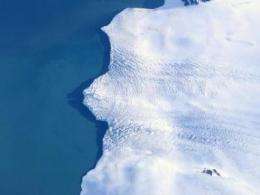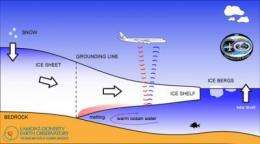Peering under the ice of a collapsing polar coast

Starting this month, a giant NASA DC-8 aircraft loaded with geophysical instruments and scientists will buzz at low level over the coasts of West Antarctica, where ice sheets are collapsing at a pace far beyond what scientists expected a few years ago. The flights, dubbed Operation Ice Bridge, are an effort by NASA in cooperation with university researchers to image what is happening on, and under, the ice, in order to estimate future sea-level rises that might result.
Since 2003, laser measurements of ice surfaces from NASA's ICESat satellite have shown that vast ice masses in Greenland and West Antarctica are thinning and flowing quickly seaward. Last month, a report in the journal Nature based on the satellite's measurements showed that some parts of the Antarctic area to be surveyed have been sinking 9 meters (27) feet a year; in 2002, one great glacial ice shelf jutting from land over the ocean on the Antarctic Peninsula simply disintegrated and floated away within days.
NASA's satellite reaches the end of its life this year, and another will not go up until 2015; in the interim, Operation Ice Bridge flights will continue and expand upon the satellite mission. In addition to lasers, the plane will carry penetrating radars to measure snow cover and the thickness of ice to bedrock, and a gravity-measuring system run by Columbia University's Lamont-Doherty Earth Observatory that will, for the first time, plot the geometry and depth of ocean waters under the ice shelves. The gravity study is seen as key because many scientists believe warm ocean currents may be the main force pulling the ice sheets seaward, melting the undersides of ice shelves and thus removing the buttresses that hold back the far greater masses of ice on land.
"What our colleagues see from modeling of these glaciers is that warm ocean water is providing the thermal energy to melt the ice," said Lamont geophysicist Michael Studinger, a co-leader of the gravity team who will be on some of the flights. "To really understand how the glaciers are going to behave, we need the firsthand measurements of water shape and depth." Earlier this year, an icebreaker cruise co-led by another Lamont scientist, Stan Jacobs, sent an automated submarine to look under the region's Pine Island Glacier, which has been moving forward rapidly in recent years. Its bed, where the ice contacts rock, is below sea level, and scientists are concerned about what would happen if a sudden large movement were to introduce seawater underneath. The plane flights, over some six weeks starting Oct. 15, are aimed at providing a wider-scale picture of Pine Island and other targets.

For each of some 17 flights, the 157-foot DC-8--too big for runways on Antarctic bases--will make an 11-hour round trip from Punta Arenas, Chile, with two-thirds of each trip spent getting to Antarctica. There, the plane will fly survey lines as low as 1,000 feet, some of them along sinuous glacial valleys that may test the nerves of both pilots and scientists. Some flights will investigate the region's open sea ice, which also seems to be in decline. The campaign will cost about $7 million.
"We learned how fast the ice sheets are changing from NASA satellites," said Lamont geophysicist Robin Bell, who is helping lead the project. "These flights are a unique opportunity to see through the ice, and address the question of why the ice sheets are changing."
"A remarkable change is happening on Earth, truly one of the biggest changes in environmental conditions since the end of the ice age," said Tom Wagner, cryosphere program scientist at NASA headquarters in Washington. "It's not an easy thing to observe, let alone predict what might happen next. Studies like this one are key."
Investigators from the University of Washington and University of Kansas will run their own suites of instruments. The scientists and engineers will narrate the progress of the mission on several blogs, including one hosted by NASA, and another by Lamont, as well as via twitter.
Source: The Earth Institute at Columbia University (news : web)

















